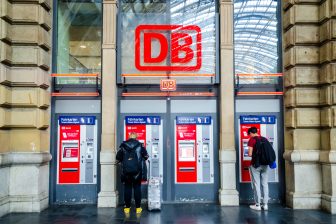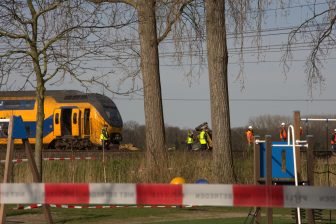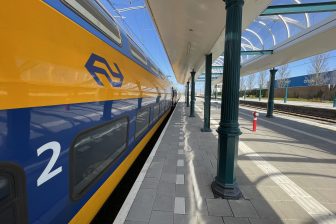ProRail CEO wants more tests on the track
ProRail CEO Pier Eringa wants to do away with risk-avoiding behaviour in the rail sector. “I would like more tests on the track, even if they sometimes end in failure. By fully testing new technology, the rail sector will make more rapid progress,” says Eringa in an interview with SpoorPro. Trains that hover on a magnetic layer over the track, self-driving trains, and generating solar energy from the track are some of the possibilities for the future. On Tuesday 28 March, Pier Eringa will open the RailTech Europe 2017 expo, together with NS CEO Roger van Boxtel, ERA’s ERTMS head Pio Guido, and Jan van Zanen, Mayor of Utrecht.
“In the coming years, we will have deal with a number of issues. The rail network will be used more intensively, amongst other things because of the High-Frequency Rail Programme (Programma Hoogfrequent Spoor, PHS). At the same time, various maintenance and renewal projects are planned. How can we avoid running into trouble? Innovations to take on these difficult problems are more that welcome.”
Working as the trains run
“For example, how are we going to deal with the pressure of increased train traffic while properly maintaining the track?” According to the CEO, it must be possible to work on the track while the trains keep running. “There are a number of technologies that would allow this to happen, for example sensors that send a signal and make safety vests vibrate if a train is coming. It is also possible to work behind fences. Sometimes there are already existing technologies from abroad that we can use.”
Pier Eringa believes that there is too much hesitancy among regulators and within ProRail to adopt new technology. “We have to use new technology in order to innovate. This means that we take the risk that things sometimes go wrong, but we need to keep going forward. I want to do away with risk-avoiding behaviour. That means that we will no longer hurriedly adopt a safety rule because one incident has taken place.” As an example, the CEO named the adoption of the double deactivations of the track after the fatal train accident in Amsterdam Westerpark in 2012. “At the time, there were very good reasons to build in extra safety guarantees. But it would be good if, after some time, we could re-evaluate these rules. I want us to make careful deliberations.”
Improve the reputation of the track
According to the CEO, an example of taking risks to make progress is the start of the high-frequent trains on the track between Eindhoven and Amsterdam this December. “ProRail and NS will run six Intercity trains an hour on the A2 corridor. All of us in the rail sector are very excited about this. Without doubt, there will be days that will not run so smoothly. But it would be nice if passengers, interest groups and politicians then think: it’s a shame that it has not worked so well, but it is good that they are trying.”
Eringa believes that passengers and society in general will be more understanding if ProRail continues to improve its reputation. In recent years, considerable progress has been made, he asserts. “You can see that our reputation has got better in recent times. Passengers and non-passengers alike give us a better score. When I started at ProRail two years ago, there was a perception that we had financial shortages and there were many defects on the track.” The CEO points to a draft report from an external accountant on his desk. “Now we have a satisfied accountant and our operational performances have improved.”
New management structure
The new management structure within the rail maintenance company has led to “more peace” in the organisation, adds Eringa. “You can see that we have got a more horizontal organisation. There is no longer a distance between the leadership and the rest of the employees. And that has had an effect throughout the organisation.”
Focus on transparency
Another way to further improve ProRail’s reputation, says its CEO, is to be transparent about how the rail network is working. “At ProRail we now have a greater focus on transparency. For instance, we will soon publish internal investigations into large disruptions on our site. This means that we can also show that we are self-critical. I think that if we show passengers how an incident could have happened, they will also have more understanding. In addition, we can demonstrate what we are doing to prevent future disruptions.”
Disruptions
Eringa also mentions that a central team under ProRail’s leadership will soon be created that will make decisions about timetables when there are large disruptions on the rail network. “There will be one captain on the ship who will be the contact point for all emergencies: the so-called Officer of Service – Rail. This person will for example immediately take action when there is an incident such as a stranded train in the HSL tunnel in Rotterdam.”
“Currently, when large disruptions occur, both NS and ProRail are responsible for making decisions about the NS timetable. On each occasion, they consult together about which trains can run, and which trains can’t. Within the new setup, the Officer will make decisions about an adjusted timetable for all transport providers and work can be done more quickly on restoring train traffic.”
Apply new technologies
“By operating with more transparency we are also exposing our vulnerabilities,” says Eringa, “but we have to go through this phase so we stop being the one that gets the blame. Now we have the basics running well. Instead of just being focused on the daily operation, we also have to focus on the future of the track, and adopt new technologies.”
The new technology could, according to the CEO, lead in the future to “trains that hover on a magnetic layer over the track”, which would mean “less noise and vibration”. Self-driving trains on the track are also a possibility. “Last summer, we ran a successful trial with DB Cargo of goods trains running along the Betuwe Route on automatic pilot.”
“It would be a shame if lorries are soon driving in ‘trains’ behind each other on the motorway, while it is the railway that is best suited to self-driving transport. The technology for self-driving trains will soon be possible with the introduction of the new track safety system ERTMS, so it is good to start working on this quickly.” According to Eringa, an enormous number of self-driving cars would be necessary to transport as much as a train. “The strength of the rail infrastructure is that it can process very large volumes, and can reach city centres and the ports of the Maasvlakte.”
Solar cells on the track
Furthermore, ProRail wants to allow solar cells to be used on the track. “That means that we need to investigate whether something can be placed between the sleepers to capture the sun. We can also place solar cells on noise screens, and we want to put these cells on station roofs. If we have a good basic reputation, we will be motivated to think more about the future, and then we can develop more of these sorts of initiatives.”
Such developments also make a career in the rail sector more attractive, asserts ProRail’s CEO. “Imagine if you could apply for a vacancy as a drone pilot to do track inspections, or as a specialist in solar energy.” New technologies could be interesting for working in the field. “Currently we are working with many traditional objects in the rail sector, some from just after the Second World War. If we make it possible for rail staff to resolve disruptions virtually, with an iPad, we attract young people.”
During RailTech Europe, ProRail will give knowledge workshops and conference presentations, and will exhibit its latest innovations. A large number of specialists and representatives from the management team will be at the ProRail stand, and they will have a dialogue with other rail professionals about important developments in the rail sector.
For more information, please visit the RailTech Europe website: https://www.railtech.com/




